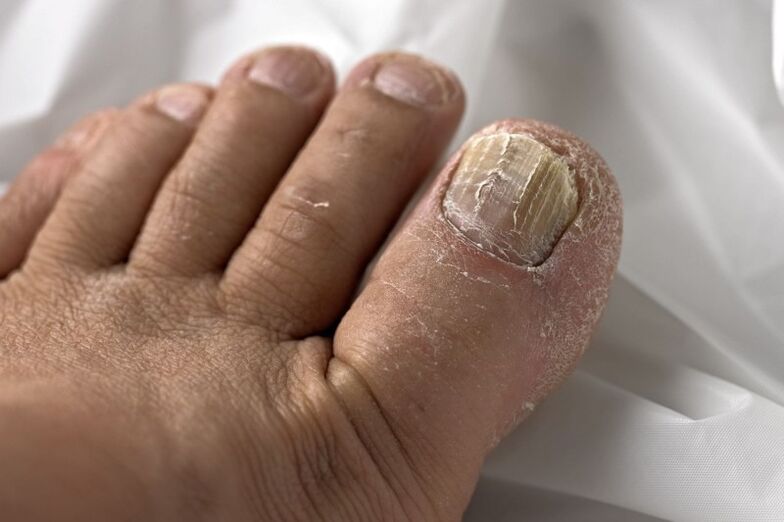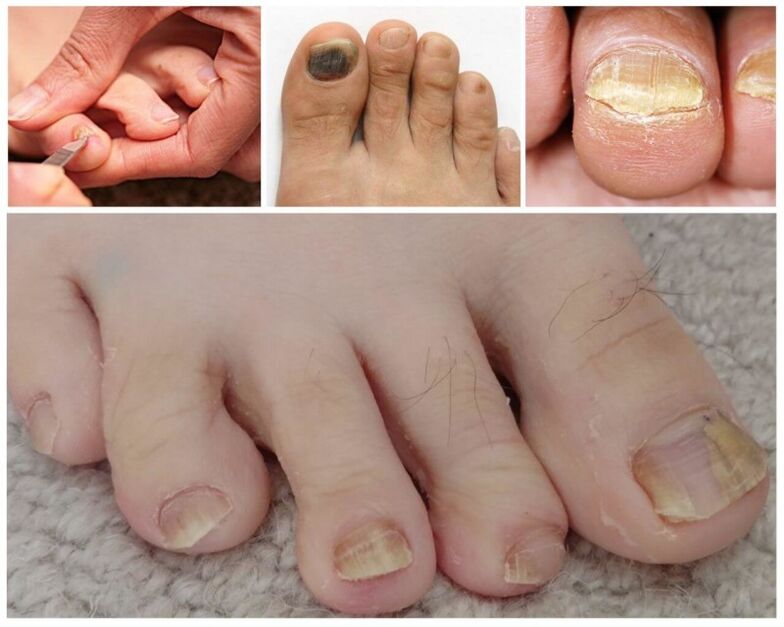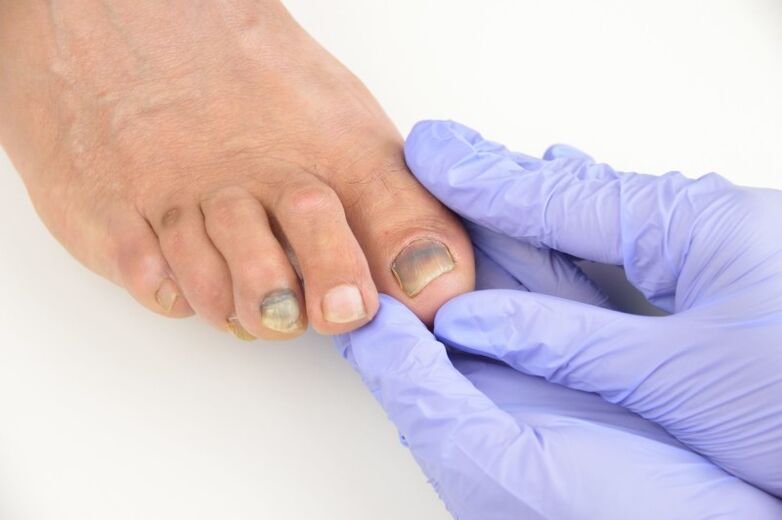Many people are faced with diseases that affect the nails. But not everyone knows which doctor treats toenail and fingernail fungus. Refusal to treatment leads to the development of malnutrition. This can be dangerous as the infection continues to develop and "take over new territory". When the first symptoms of a lesion appear, it is important to seek professional help immediately. The choice of the doctor depends largely on the general condition of the patient.

Symptoms of mycosis
In the early stages, fungal infections do not manifest themselves in any way. The appearance of the first symptom was ignored. Healthy nails are pink and shiny. When infected, it fades to a dirty gray.
Gradually, the nail plate thickens and it becomes difficult to cut the free edge with scissors. In later stages, hyperkeratosis develops and the nails turn yellow and brittle. Over time, the plate moves away from the nail bed. As a result, the resulting voids are filled with pathogenic microorganisms that are part of the skin microbiome. decrease in immunity. There are complications in the form of bacterial components attached. In the advanced stage, the fungus spreads to the periungual ridge and the foot becomes infected. The skin was very itchy and cracked, and the toes were covered with painful cracks.

What to do to cure a fungal disease
You can restore your nails to their former healthy appearance by applying complex antifungal treatments. The patient takes oral antifungal tablets. They act on pathogenic microorganisms located in the deepest layers of the stratum corneum. The active substances of topical preparations cannot reach them, therefore, in the absence of systemic preparations, the treatment of affected nail plates with creams and ointments, solutions and varnishes with antifungal properties does not achieve the desired therapeutic effect.
There are several groups of antifungals. Some of them are active against dermatophytes, others against molds and yeast-like fungi. Make an appointment after identifying the causative agent of the nail fungus. For these purposes, scratch from the affected area. Biological material is sent for microscopy and bacterial culture. They also allow determination of the susceptibility of pathogenic microorganisms to specific groups of antifungal drugs.
Which doctor should I contact if I have fungus on my toenails
To get tested and make a correct diagnosis, you will need to contact a dermatologist, mycologist or podiatrist.
- Dermatologists are generalists in treating all types of skin conditions caused by various irritants. You need to turn to him, who can refer the patient to a mycologist if necessary.
- A mycologist is a narrow specialist. He works in the treatment and prevention of infections, which occur after fungal infections. He knows these pathogenic microorganisms so well that he can easily identify the type of infection and choose the right drug to suppress it.
- A podiatrist is a medically educated pedicure master. It treats cosmetic defects, the development of which can cause foot deformities. Its task is to detect and identify any pathological changes in the early stages of development and to produce treatments that can be implemented in beauty salons (removal of ingrown nails, cleaning of cuticles, elimination of corns and cracks). The doctor will write a referral to a narrow specialist (dermatologist, surgeon or mycologist) if a problem is found that he cannot handle.

Initial examination by a doctor
No matter who the patient goes to, the first exam is the same everywhere:
- First, the doctor interviews the patient, collects all complaints, describes the pathology in the medical history.
- A visual inspection of the affected nail is then performed to assess the condition of the skin surrounding the infected nail.
- According to the patient's complaint, according to the characteristics of the course of the disease, and according to the symptoms, the specialist makes a preliminary diagnosis, and differentiates the fungal infection from psoriasis and lichen.
- Then he had to write out the directions for the lab test. They allow you to confirm the diagnosis, identify the pathogen and indicate its level of susceptibility to existing drugs.
Treatment strategies can only be developed based on the results of laboratory studies. Treatment options may be different in each case: it all depends on what stage of the disease is.
Treatment of incipient nail fungus
The initial stage of infection has no obvious symptoms.

But it's also easy to diagnose if you pay attention to subtle changes in the structure of the nail plate.
- First, the free edge of the nail turns yellow.
- The thickness of the cuticle increases, which becomes apparent when compared to the thickness of a healthy nail.
- If the feet sweat, there will be a characteristic sour smell.
When one or three of the signs listed are detected, you will need to make an appointment with a mycologist. If the clinic does not have such a doctor, it can be useful to consult a dermatologist. At this stage, the infection can be treated with folk remedies and antifungal medications used for topical treatment. The treatment plan for this case is as follows:
- Every day, pre-solder the legs in the tub and add a decoction of chamomile or potassium permanganate. They disinfect the skin and prevent the adhesion of bacterial components. Best done at night.
- After thoroughly drying your nails with a towel, apply a cotton pad to the affected plate and moisten it well with a solution of apple cider vinegar, vodka and glycerin (the first two ingredients are mixed in half and a scoop of the third ingredient is added to them). After half an hour, remove the compress. The fungus cannot tolerate an acidic environment, so it stops reproducing.
- In the morning, apply a few drops of iodine (5%) to the affected plate daily.
- Every other day for the first month, you need to cover your nails with an antifungal varnish. In the second month, the varnish is applied twice a week and every 7 days for the following months.
Experts recommend treatment until the healthy nail plate has fully recovered (about three to four months). It is useful to visit your doctor regularly and monitor the effectiveness of the therapies you are taking with him. If necessary, a dermatologist or mycologist can alter the treatment regimen by adding an antifungal cream or antiseptic solution.
Treatment of advanced mycosis
If a comprehensive treatment regimen does not help overcome the fungal disease, a specialist may decide to remove the affected nail. This can be done in a number of ways.
Surgery allows the indicated problem to be resolved in the shortest possible time. For implementation, patients receive a referral from a surgeon. Doctors use a scalpel to remove the nails, then stitches and a sterile dressing are applied to the wound. The recovery period lasts two weeks. The patient was receiving antibacterial therapy and went to bandage the operated finger daily. Go home after being discharged from the hospital.
If there are any contraindications to surgical intervention, a special patch is used to remove the nails. They are glued to the board and left there for five to six days, after which the condition of the nails is assessed. If necessary, restart the process. The composition of the patch contains substances that soften and dissolve the stratum corneum. Then use scissors to remove the residue of the nail.
To remove the plate, the patient can be offered laser therapy. With the help of special light pulses, the stratum corneum is burned. The procedure is painless, performed under local anesthesia, and has no postoperative period. In order to achieve the therapeutic effect, eight procedures are required. Many people are not satisfied with this.
Precautions for patients and their families
Fungi reproduce through spores, which spread over long distances with air currents and fertilize any surface. Infection is spread indirectly through contact with contaminated objects. Therefore, if there is a sick person at home, his family should take special precautions. This is forbidden:
- Putting on the patient's shoes with bare feet;
- Use the bath accessories and tools he uses for pedicures;
- walking around the house barefoot;
- Ignore personal hygiene rules.
It is useful to have changeable shoes on your feet when entering a bathroom, tub or sauna. It's important to take proper care of your feet, continuously strengthen your immune system, and enrich your diet with foods rich in vitamins and minerals. Consult your doctor at the first signs of infection.
























